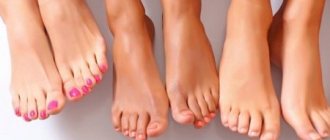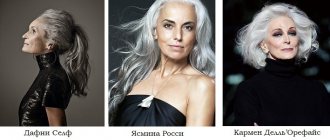What determines hair color?
Our body is a system of interconnected organs. It exists autonomously, although nature has created such connections that are not visible to the eye, but tangible. They are detected at the genetic level, so a person’s appearance, character and even habits are formed long before birth. Our relatives, whose names we may not even know, took part in this process. Knowing how to understand these connections, you can scientifically predict what color a newborn’s hair will be.
Recessive and dominant genes
To do this, you need to know which parent has stronger genes (dominant) and which has weaker genes (recessive).
A situation may arise in which both mom and dad have recessive genes - then the shade of the baby’s hair will depend on the genes of more distant relatives.
Specific features of the external and internal structure of the body will help determine the recessiveness or dominance of genes. People with green or brown eyes, wavy hair, a positive Rh factor, as well as balding men are considered carriers of weak genes.
People with strong genetics have clear skin, straight hair, and their blood Rh factor is negative.
Superstitions
But it is not always possible, even based on these theoretical calculations, to guess the hair color of the unborn child. It seems curious when a baby is born with hair of a color that neither parent has. This is often associated with the appearance of red-haired babies.
The area of superstitions spread by the Orthodox Church includes the theory of telegony, which suggests that the genes of all the mother’s lovers participate in the formation of the child’s heredity. The reason for the appearance of this theory is due to the fact that orthodox religious people thus want to prove the immorality of premarital sexual acts.
What determines who a child will be like? — Mom and child
But in general, I have such a mix of looks from my dad and my mom that my dad’s friends think that I’m a copy of my dad, and my mom’s is my mom. Recently, my mother’s friend flew to the country where I now live, who had never seen me, recognized me at the airport in a split second, because she looked very much like my mother.
Yesterday I came across a post about eye color, and it became terribly interesting what kind of doll my husband and I could get. Maybe someone is interested too. Please under cat.
They have the same hair as the men from my husband’s family - one has thick, black, curly hair, the other has light, straight, wavy hair.
Studies have shown that the child's height will be average, relative to the parent's. If dad is 180 cm tall and mom is 160 cm tall, then the child will be 170 cm tall. This is approximately. So if the parents themselves are tall, then the child will grow up to be the same, and vice versa. But exercise can also affect growth. As a rule, in volleyball or basketball, the warm-up is done on the spine.
It is very difficult to say what genetic combination will result. People try to predict, but nature and genetics just do their thing. Strong (dominant) and weak (recessive) genes take part in the formation of the combination of genetic characteristics of a child.
What hair color will your daughter have if her mom is blonde and her dad is brunette? Is it possible for blue-eyed parents to have a baby with brown eyes?
To try to determine the color of a child’s hair with maximum probability, you don’t need to go to a fortune teller, but you just need to know some of the laws of genetics and the factors that directly influence this. The color of a baby's hair depends, of course, to a greater extent on the genes received from mom and dad. But one should not discount the genes that relatives have: grandparents.
Color and thickness
In fair-haired babies, hair is not thick in the first year of life. There is no need to worry: the formation of a child’s hair continues during the first five years. Until this time, insufficient density should not give cause for concern.
Moreover, you should not use the advice of traditional medicine - following them can only aggravate the situation and cause:
- fragility;
- dryness;
- damaged roots;
- loss of color.
Proper hair care involves a healthy diet, which includes foods high in zinc, magnesium, calcium, vitamins A, B, and C.
Hair density is not related to the frequency of haircuts. The only thing they contribute to is hair coarsening. Therefore, parents should put superstitions aside - nature will take care of the future.
Some parents, in the hope of avoiding hair loss in their child, shave his head. This is highly discouraged, because shaving can damage the scalp, and this process will not have any effect on the hair.
Color change
There is no need to be alarmed if the color and structure of newborns’ hair begins to change rapidly: these processes are observed in almost everyone. Hair can change color several times. These processes are caused by the restructuring of the body, which actively occurs during the first 5 years of the baby’s life: during this time, the child’s hormonal balance is adjusted, important components responsible for the external and internal structure of the body are redistributed.
Hair darkens
More often than not, children's hair darkens. Pediatricians find it difficult to give a definitive answer to the question of why this happens. Most people agree that after a child is born, the distribution of melanin pigment in his body changes.
In the womb, most babies have light hair because it contains a significant amount of pigment. Its content can remain at the same level after birth, which is why in the first months and sometimes years, naturally dark children remain blonde.
After birth, the baby's hair begins to change structure and color. One of the pigments responsible for light is eumelanin. The more it is in the hair, the darker it is. The content of this pigment, unlike melanin, gradually increases. You can notice this process in photographs of children, in which their hair becomes darker and darker as they grow older.
Baby's hair becomes lighter
Less commonly, there are cases when babies' hair turns lighter. The reason for this process lies in the decrease in eumelanin content in the hair.
Hair and growing up
Most often, hair still undergoes some changes as the child grows older. The density, shade, and waviness of hair will be fully established only after puberty. Of course, they will not be radically different from the hair that grew after pumping out the vellus hair, but they will still change somewhat. Although sometimes after 15 years, teenagers with very light hair darken and become distinctly brown-haired.
Of course, that baby silky strand that you will lovingly keep in a box along with other family heirlooms is only a distant semblance of the hair that will appear on your child's head later. But a baby's first hair needs the same careful care as an adult's hair.
Fiery color
Most parental superstitions are associated with red-haired children. Since ancient times, this color has entailed a trail of mystical ideas. In the era of nanotechnology, scientists have tried to dispel these superstitions and, based on reliable facts, prove that red hair color is almost no different in characteristics from other types.
Its carrier is the MK1R gene, informally known as the “ginger gene.” In terms of the manifestation of strength, it is recessive. This means that a child will be born red-haired if there are two “ginger” genes in his gene structure. Therefore, it is not always the case that in a large family with red-haired parents, all the children will necessarily turn out to be red-haired.
The probability of acquiring this color in these cases is 1 in 4. The MK1R gene can lie dormant for several generations in a row and appear at a time when it was not expected, and ignorance of the laws of genetics will lead to the fact that the birth of a red-haired baby will cause not very good assumptions on the part of the father.
If the pigment melanin is responsible for light color, and eumelanin is responsible for dark color, then pheomelanin is responsible for red hair. Its presence increases the risk of melanoma. Even people with pale skin and blond hair are less likely to get it. But the distinctive character a priori attributed to redheads remains a stereotype, not confirmed by scientific research.
Maintaining natural hair color and caring for it
To ensure that the baby’s hair looks well-groomed and its color is natural, parents need to follow simple rules
Balanced diet rich in vitamins and microelements
The baby begins to eat already in the womb: the supply of the child with the necessary nutrients depends on the mother’s diet. If a mother has problems with her hair during pregnancy, they need to be resolved quickly so that they do not negatively affect the child.
No food component is as beneficial for a baby as mother's milk. It contains the necessary nutrients for the normal development of the child's body.
Starting from the second year, the child’s diet should be expanded with supplements rich in proteins, fats and carbohydrates. To restore hair and maintain its normal condition, vitamins A, B, E, C and D are needed.
Washing head
The baby's hair needs to be washed daily. It is recommended to use shampoos no more than twice a week, and it is better not to wash your baby’s hair with soap at all. If it is time to wash your child's hair with shampoo, the detergent should be rubbed into the palm of your hand or warmed with warm water. This is done so as not to frighten the baby with cold liquid.
During bathing procedures, parents need to carefully monitor whether there is any dirt left in the hair and whether the skin is sufficiently moisturized.
Intense hormonal changes in the baby’s body lead to poor skin condition, which is characterized by the appearance of a crust. It will easily come off on its own during bathing if you pre-lubricate it with moisturizing baby cream. After bathing procedures, the child’s hair should be slightly blotted with a soft towel and allowed to dry on its own.
Combing
The baby needs to comb his head every day, and this does not depend on the thickness of his hair. Thanks to combing, the child’s hair becomes smooth and acquires a natural color, and the scalp is massaged. To comb out all the dirt from your hair, you need to change the direction of combing: from right to left, from top to bottom, against growth and vice versa. To ensure uniform hair growth, partings should be made in different places.
You need to pay special attention to the comb: it should not be sharp or hard. Special brushes with natural bristles are produced for children. Also, do not forget that combs, like toothbrushes, are short-lived. Dirt, skin particles, and lost hair gradually accumulate on them, which contributes to the spread of infection.
Compliance with the above rules is the key to excellent condition of the child’s hair and its natural color. Violating the recommendations will lead to the baby’s hair becoming dirty, tangled and brittle.
You can calculate the hair color of your unborn child, but is it worth doing? Conduct genetic tests, determine the recessiveness or dominance of genes, find out what kind of hair great-grandmothers and great-grandfathers had in their youth... Nature or God themselves decreed that they brought future parents together, and not much is required of them: to love their child, despite then whether he is dark, light or red.
A baby who has just been born may shock his mother with the color of his hair. Sometimes it happens that parents have dark hair, but the baby may have light fluff on his head. In fact, the color of a child's hair at birth does not mean anything. As a rule, hair color changes gradually.
What happens before birth...
An interesting fact is that while still in the mother’s tummy, hair on the baby’s head grows and falls out into the amniotic fluid; such hairs are called lanugo. The structure of these first hairs is not the same as normal ones. They are much thinner and lack follicles. When a baby is born, the lanugo may remain on the baby's head or fall out completely. Parents should not pay particular attention to the quality of the fuzz on the baby’s head. In most cases, one cannot judge by the external signs of a child’s first hair what it will become in the future. Lanugo completely disappears from the baby’s head by 3-4 months, and in their place, stronger hairs grow.
Parents may be greatly surprised by the shade of their child's hair if it does not match any of the gene carriers. As mentioned above, it is still quite early to draw conclusions. As the baby grows, the child's hair color also changes. Their shade can either lighten or darken. By the way, the shade of hair that a child will have in the future is laid down in the womb, at the genetic level.
There are two types of hair pigmentation: eumelanin and pheomelanin.
. The first of them affects the result of dark shades of hair, and the other is responsible for light and red hair. How these two pigments will interact with each other in the future depends on the genes. The process of producing pigments occurs due to melanocytes, cells that are programmed even before the baby is born. This process cannot be interfered with or influenced in any way. The process of changing hair color can drag on until primary school age, and in some cases even before the child reaches puberty.
Scientists have concluded that the effects of pheomelanin are responsible for red hair shades.
It is worth noting that factors such as stress, insufficient nutrients can affect the functioning of melanocytes and, as a result, a malfunction will occur. Gray hair that appears too early will be an indicator of such a malfunction in the child’s body. However, this process has nothing to do with cell aging. Therefore, it is impossible to make any assumptions about how the child’s hair color will change. It is also possible that the hair color may not change at all during the child’s life, but will remain the same as at birth.
Problems you may encounter
White hair. Medical issues. A child from birth to one year. Care and education of a child up to one year: nutrition, illness, development. Baby's hair and care for it. After the birth of the child, the process of hair change continues, and my hair is blond with red...
hair in babies. ...I find it difficult to choose a section. A child from birth to one year. And the question is tormenting me: will my beauty’s hair change? Well, that is, color, structure? And is it worth cutting her head at the age of 1, as our grandmothers did?
Discussion
We didn't cut hair. Egor was born tarry black (there was even a second of doubt that he was mine! My husband and I were blond and light brown as children) then the fluff grew back and became light.
It's all nonsense about shaving!
cutting your hair is nonsense, right, but your hair will change color another 100 times...
A child from birth to one year. Care and education of a child up to one year: nutrition, illness, development. Mommies, please tell me, at what age does a child’s head shape develop? My son was born with a slightly elongated head shape and a flat back of the head, but...
Discussion
the older one still has a sloping head on one side, but it’s not noticeable under the hair. I was also very worried, but then I came to terms with it.
We also had a large bevel, it was very noticeable. The doctors only advised us to put a pillow on it so that we wouldn’t lie on one favorite side all the time. Well, a special pillow that we refused to sleep on. Now we are a year old and everything has leveled out on its own, nothing is noticeable
04/21/2009 01:15:16, it was
For some reason, my hair color changes to the color of the next child completely involuntarily. When Edik was there I was a blonde, under Ruslan I was a brunette, and now I’m a blonde again - my Yurochka is fair. And every child changes me towards youth...
Discussion
My daughter has changed me a lot in just a year. When I was expecting my first child, I didn’t even think that it would be a girl. And she wanted a boy for her second child, although everyone said that she needed a girl... And now I feel that the relationship with my daughter is completely different, not the same as with my son. A year after her birth, I realized that I had become softer, somehow “homely”... I learned to tightly control my emotions (with my elder I could yell and slap her on the butt, but now I can’t). And now I want a third thematic child, a girl. I hope everything works out :)
And my son (1 year 10 months) chooses shoes and makes me put on beautiful elastic bands, hairpins or headbands on my hair. I used to be more relaxed about my personalities. My son also made me a good housewife, I began to cook with pleasure, and learned to clean the apartment every day.
The baby has not yet been born, and the family is already starting to guess who the child will be like? And my mother wonders: what will my child look like? How genetics affects a child’s appearance and personality, read on.
How to find out who your child will be like
You probably have more than once imagined the appearance of your child during pregnancy, imagining who the child will look like. Will he be tall like his husband? Will his hair be curly like yours? Or maybe he will inherit his grandfather's sense of humor?
Experts say that the 46 human chromosomes contain between 60,000 and 100,000 genes (which make up DNA). The child gets 23 of his mother's chromosomes and 23 of his father's. With every possible combination of genes, one parent could theoretically produce 64 trillion different children. This should make you realize that it is impossible to predict what a child will be like. The science of genetics is very complex, but you can at least get a quick overview to fuel your imagination.
Do you remember anything about genes and fruit flies from school biology lessons? Back in those days you were told that a dominant gene displaces a recessive one. Scientists have long known that humans are more complex than fruit flies. But only recently have they begun to understand how much more complicated it is.
As it turned out, human characteristics are characterized by polygenicity, that is, their formation is influenced by a large number of genes. To complicate the picture even further, imagine that for some characteristics, such as height, weight, and even character (read more in the article), the environment has a big influence on which genes prevail.
What will the child look like: the color of the child's eyes
What will the child look like: height and weight
For a rough estimate of height, determine the average height of mom and dad. Then add a centimeter for a boy, or subtract a centimeter for a girl. If your height is 158 cm, and your husband’s height is 164 cm, then the average height will be 161 cm. Thus, your son’s height will be about 162 cm, and your daughter’s height will be 159 cm. Of course, such an unpredictable science as genetics does not tolerate such rough measures. So it's likely that your child will be a head taller than the taller of the two of you, or a head shorter than the shorter one.
Nutrition and health have a very big impact. If your daughter's genes set her height at 160 cm, then she may not reach this mark due to inappropriate nutrition or some external factors that interfered with normal development. In another case, it may outgrow the set point thanks to a balanced diet, which is also proven by research in recent years.
But it’s impossible to guess whether your child will be thin or fat. Genes only approximately characterize the future weight of the child, but do not guarantee it. Of course, when both parents are overweight, the likelihood of similar problems in the child is quite high. can be explained by genes, family lifestyle, but rather a combination of both factors.
What will the child look like: hair color
As a rule, dark hair color prevails over light hair color. But as in determining eye color, hair can take on different shades, mixed from the hair color of both parents. It depends on the pigments contained in your and your husband's hair, and how they mix. Parents with a similar hair color may have a child with a slightly different shade of the same color.
Unexpected combinations occur among parents with different hair colors. This happens when the recessive color gene of one parent interacts with the gene of the other parent. So it is possible that a dark-haired partner, but with a recessive white gene, interacting with the other partner's white gene, will have a child with blond hair.
Red hair color is considered dominant in relation to white
Regarding red hair color, which was previously considered recessive, it is now recognized as dominant in relation to white. You may be a redhead and not even know it because the red tone in your hair is covered by stronger brown or black pigment.
Who will the child be like: personality
According to experts, many personal characteristics (for example, reaction to noise) are genetically embedded in a child from birth. But experts also believe that the environment also has a huge influence on the formation of behavior. For example, the desire to take risks may be genetic (the adventurism gene has recently been discovered), but you can make sure that this same restlessness and thirst for adventure will manifest itself to a lesser extent, in a different way, or disappear altogether.
In the same way, creative people, or those with absolute pitch (the existence of corresponding genes has also been scientifically proven) will perform well in an environment conducive to this. But if they have never touched brushes or musical instruments, then the talent will simply disappear. Fortunately, this also works in the opposite direction. Thus, a child without any predisposition will be able, through effort and work on himself, to develop an ear for music or artistic skill. It is unlikely that you will find a trait that you cannot develop yourself, or for which the gene is completely absent.
Who will the child be like? This quite often worries future parents. But really, is it possible to know in advance what a baby who hasn’t even been born will look like? With the sex of the child, everything is more or less clear: it depends on which cell of the man fertilized the egg.
How to find out which ones will...
Some parents who are expecting their first child can’t wait to determine their child’s hair color. In principle, this is possible if you understand a little about the laws of genetics. You don't even need to undergo any procedures for this.
So, there are 5 factors to predict this, namely:
- The hair color of the unborn child depends on the combination of the genes of the mother and father. It is worth noting that genes are either dominant or recessive, i.e. weakly expressed and strongly expressed. The strongest, dominant genes dominate over the weak, recessive genes, thus, at the moment of the birth of a new life, they are passed on to the future baby. So, if a father is a carrier of a strong hair gene, then his children will inherit this gene.
- If both father and mother are carriers of dominant and recessive genes, then the outcome of their struggle cannot be predicted. And here the genes of previous generations can play an important role, influencing the result. In this case, it will be possible to make only approximate assumptions about the hair color of the unborn child.
- You can predict the outcome of strong or weak genes yourself as follows. If you have brown or green eyes with a normal blood clotting rate or you have a tendency to sudden hair loss, this applies to men, then you have strong genes. Weak genes are characterized by the presence of straight hair, lack of skin pigmentation and negative Rh factor of the blood.
- We must not forget that such a science as genetics does not provide 100% accurate calculations. With its help, you can determine only the most probable options; an exact calculation will not be possible. As mentioned above, the genes of previous generations influence and are passed on to the future baby. Thus, it would seem that the parents are dark-haired, but the child can. And then it turns out that my great-grandfather had red hair too. This can often happen when you are expecting your first child. So, the likelihood of a child's hair color depends on everyone, including distant relatives.
- It is worth remembering that changes in hair color can occur over the course of a child’s 5 years. His hair color may change several times, or it may remain the same. As a rule, hair color can change in the first two years of a child's life, and completes its formation by 5 years.
IMPORTANT! With the onset of puberty in a teenager's body, testosterone levels change, which in turn can affect changes in hair color.
Hair color.. . If the mother has brown hair and the father has brown hair, what color will the child's hair be?
Alice)
It can be different, but there is a high probability that they are dark. We recently took biology class. It’s impossible to predict exactly, but the dark color is stronger. And let’s say out of 5 children, 3-4 will have brown hair, and 1-2 will have brown hair.
Catherine
Inheritance of hair color occurs through several genes (if memory serves - 16), so it is generally impossible to say in advance what combination of these genes a child will get and what color the child will end up with. Although yes, the darker the parents' hair, the higher the likelihood of having children with the same dark hair
Schwimmmeister
Mother nature is so unpredictable! ! There is absolutely nothing that can be said about this!! My hair is dark brown, my eyes are green, my husband is blond (whiter than white) with blue eyes - that is, his genes are recessive (everyone in his family is white)…. So what? the child is his copy, although according to all the laws of biology it should be different, because in my family there are no blondes or blue eyes (green and brown only), that is, my genes, Vasya, should have been dominant... but no
We determine according to the parents...
Quite often it happens that young parents begin to argue about whose facial features will dominate in their future child. It’s better not to argue, but to try to understand the basics of genetics. What are genes, how do they combine with each other and how do they influence the external characteristics of the child? A gene is a part of a DNA molecule that stores and transmits hereditary information. But it is important to note that not the entire set of genes is inherited. For example, a particular person is a carrier of the strabismus gene, but this does not mean that he himself has some vision problems. All the genes of a particular person taken together are called a genotype. And, based on it, the process of forming a phenotype begins - a set of transmitted genes.
It is in principle possible to calculate the color of a child's hair. Basically, the unborn baby will exhibit the strongest, dominant genes. So, for example, the gene for light hair shades is weak and recessive. This is why it is quite difficult to meet people with very light natural hair shades on the street.
Traits that are caused by strong, dominant genes are:
- Large, expressive eyes
- Plump lips
- Dark hair color and curly hair
- Brown eyes
- Small stature
- Dark skin tone
- Freckles
- Good hearing
- Right-handedness.
Recessive genes include:
- Blue or green eyes
- Thin lips
- Light hair color
- Straight hair
- Bright skin
- High growth
- Left-handedness.
What kind of interaction occurs between genes? It does not happen in all cases that strong genes suppress weak ones. Therefore, it is necessary to take into account not only the external data of the parents, but also previous generations of the family. The color of a child's hair depends on all of the above factors.
Many mothers, while expecting a baby, often think about how he will be born, what color eyes and hair he will have, what nose, lips and height he will have. Will he look like his parents or will he inherit the features of one of his relatives? Genetics can provide answers to these questions even before the baby is born.
Based on the laws of genetics, let's look at the algorithms by which a child's appearance is most often formed.
Eye color
If dad has dark brown eyes and mom has blue eyes, then the child is likely to have brown eyes. The gene for brown eyes is dominant (strong), and the gene for blue eyes is recessive (weak). If both parents have brown eyes, then they are unlikely to have a child with green, gray or blue eyes. As time passes, they will begin to darken, gradually turning brown.
But if both parents are blue-eyed, then the baby will most likely have blue eyes.
How to calculate the eye color of the unborn child's hair? Based on the color of the parents
Debora
It can be calculated. But this will still not give any results. According to these indicators, I should have gray eyes and blond hair. But everything turned out the other way around! You just draw the image of a child in your mind, and that’s how he will be born! Verified))))
N.
Using my example, I can prove that dark color does not always dominate. I am a grey-eyed, brown-haired woman with fair skin. The husband is brown-eyed, dark brunette. Both daughters look like me, that’s genetics))) I’ll warn you right away - the children are definitely from my husband))))
User deleted
No way. Even if there is a 1% chance, the child can fall into exactly this percentage... I thought that my daughter would inherit my brown eyes and dark hair as dominant... But no, she turned out to be fair-haired with gray eyes, like her dad :)...
Jasmine
Nothing will come out. You never know which genes will win. I myself am recessive to the extreme. And both of my sons are recessive too. My doctor has a photo of a girl she saw, so the mother is blond Lithuanian, the typical dad is Chinese, and the girl is BLONDE with a Chinese cut and blue eyes. Just like that...
Hair color
The gene for dark hair outweighs the gene for light hair because its pigment is strong. If both parents are fair, then the baby will also be born blonde or light brown. And if dad is a bright brunette, and mom is blonde, then the baby’s hair will be dark or light brown.
Interesting fact: a child who was born dark from this combination may have light-colored children in the future. The fact is that children of mixed genes receive both a strong gene from their father and a weak gene from their mother. Later, the weak gene can “merge” with the weak gene of the partner - and the child’s appearance will be light.
Also, the child may be completely different from you if he inherits wandering genes from distant relatives. Thus, in a brown-haired family, a red-haired baby may suddenly be born, and there are also cases when a dark-skinned child was born to white-skinned parents, even if there were mulattoes in the family even several generations ago.
instagram @sarahdriscollphoto
Humped nose and other features
It seems to us that this is a defect in appearance, but nature does not think so - she took this sign as a dominant one. That is, if one of the parents has a hump on the nose or protruding ears, or dimples on the cheeks, there is a high probability that such “beauty” will be passed on to the baby.
By the way, this also applies to bald spots and sparse hair - this trait is especially well transmitted from man to man. But there is no need to be upset, it is better to find the positive qualities of such a gift of nature. For example, regarding the hump, it can be reassuring to know that in some cultures a nose with a hump is considered a sign of sexuality. Scientists have also found that owners of such an organ of smell inhale 70% less harmful substances and rarely suffer from sinusitis and a runny nose.
Read also: Early bird: 5 reasons why giving birth before 30 is cool










